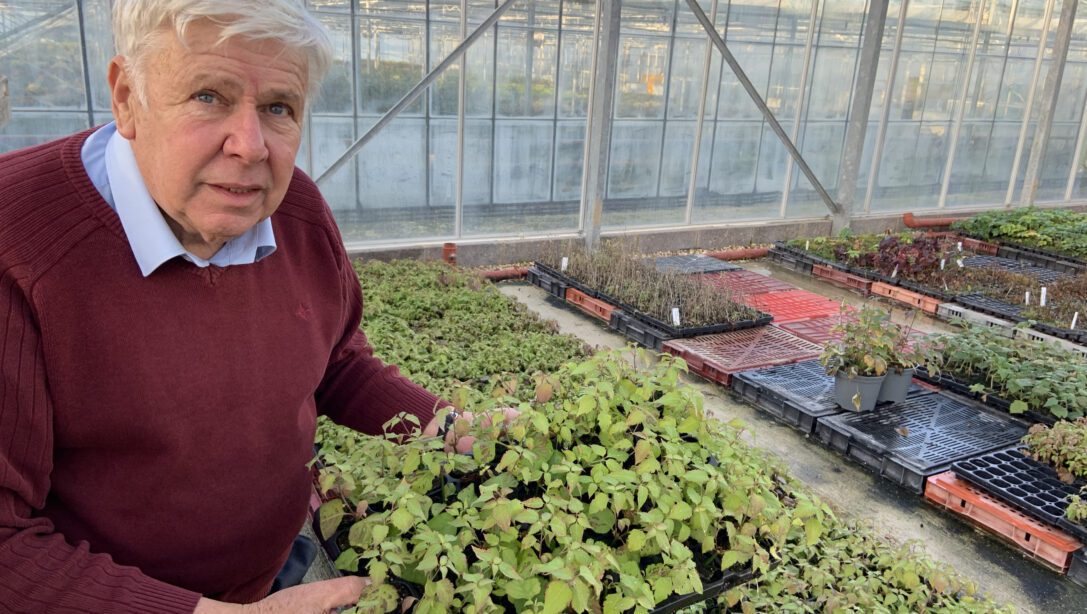There is something immensely satisfying about nurturing new plants into the world. Through various propagation techniques, from commonly practised growing from seed to the skilled art of grafting, we can make parents of the plants already growing in our garden. In this article, we look at propagation via hardwood and softwood cuttings, with expert input from Alan Postill, Master Propagator and Plant Breeder at Hillier Nurseries.
Propagation by taking cuttings is a technique that can be used on many deciduous climbers, trees and shrubs in our gardens, along with some perennials. Both hardwood and softwood cuttings are forms of vegetative propagation, a technique that is suited to those plants that don’t grow true through seed propagation. In both cases, the younger the parent plant, the better when it comes to achieving success with your cuttings.
Guide to Hardwood Cuttings
What Are Hardwood Cuttings
These are cuttings taken from deciduous plants after they have lost their leaves in winter. This is a reasonably simple and reliable propagation technique; because these plants do not have leaves, there is no need to keep them in a warm, moist environment to root. They do, however, need a little patience. It will usually be the following year before the roots and then shoots begin to develop.
Which Plants are Suitable for Hardwood Cuttings
Suitable plants for hardwood cuttings include most deciduous shrubs (abelia, buddleja, cornus, forsythia, ribes, rosa, viburnum and more), climbers (lonicera, jasminum), fruit (currants, fig, gooseberries) and some trees (platanus, poplar).
When to Take Hardwood Cuttings
The dormant season from mid-autumn all through winter (avoiding times of severe frost).
How to Take Hardwood Cuttings
Step 1:
From your parent plant, select healthy-looking shoots. Cut off the soft growth at the tip of the plant.
Step 2:
Cut the shoot into sections around 15-30cm long each. Each section should be cut just above a bud. Make the cut at a slight angle – partly to stop rainwater getting in, but also so you can easily remember which side was the top. The bottom of the section should be cut straight across, under a node (join).
Step 3:
Dip the bottom (straight) end into the hormone rooting powder.
Step 4:
You can either plant your cuttings directly in the ground or grow them in containers. If planting directly outdoors, position the plant in a sheltered spot with well-drained soil. Dig in plenty of compost or well-rotted stable manure in advance. When planting, you want two-thirds of the cutting to be below the surface, as the roots will form here. The one third above the ground should include at least one node for a single-stem plant or multiple nodes for more.
Plant your cuttings 10-15cm apart from each other. You will need to keep them in place for a full year and water them well. If there is a very cold winter, they may need protection using a cold frame or cloche.
The other option is to plant your cuttings in containers filled with a combination of compost and potting grit. Keep the containers in a sheltered spot until the following year and water as needed.
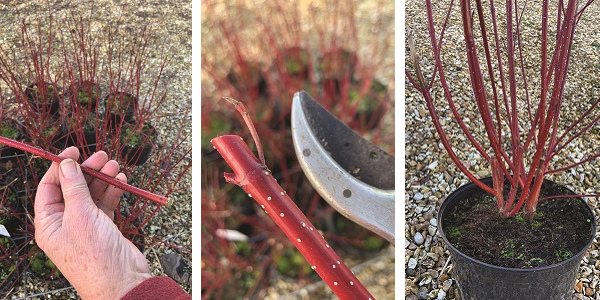 From left to right: 1. A cornus cutting, note the straight cut along the base / 2. A close up of a sloping cut at the top of the cornus / 3. Two cornus plants that have grown on from cuttings – taken about six months from the original planting
From left to right: 1. A cornus cutting, note the straight cut along the base / 2. A close up of a sloping cut at the top of the cornus / 3. Two cornus plants that have grown on from cuttings – taken about six months from the original planting
Guide to Softwood Cuttings
What Are Softwood Cuttings
Softwood cuttings are those taken from some deciduous shrubs and other plants in summer. As the name suggests, cuttings are taken from a soft section of the stem, not the mature woody growth at its base. They tend to have a high rate of success.
Which Plants are Suitable for Softwood Cuttings
Softwood cuttings can be taken from some deciduous shrubs (buddleja, fuchsia, hydrangea, perovskia), hardy and tender perennials (aubrieta, osteospermum, penstemon, pelargonium, verbena), plus some trees (betula, magnolia).
When to Take Softwood Cuttings
In the spring and early summer. Cuttings need to be potted up by mid-summer so they develop strong enough roots to get through the winter. Otherwise, wait until the following spring.
How to Take Softwood Cuttings
Step 1:
Cut a 5-10cm section of shoot from the parent plant. It is best to take cuttings in the morning, when the plant is full of fluid. Choose shoots that are not flowering, as they are more likely to produce roots. To begin your cutting, cut neatly above a bud. At the bottom end, cut just below the node. Remove any lower leaves, and if it has fleshy leaves, cut any top ones in half to help maintain moisture.
Be aware, a small number of plants require ‘basal’ cuttings – aster, chrysanthemum, delphinium and lupinus for example. For these, cuttings should be taken from clusters of young shoots at their base in spring.
Step 2:
Dip the cutting’s base in hormone rooting powder. Before doing so, it helps to slice a small ‘wound’ at the end of the cutting. This helps the roots grow at the sides and not just down.
Place the cuttings into a container filled with composted cuttings. Make a hole in the compost using a dibber. Insert the cutting, base down, so the first pair of leaves sit just above the level of the compost. Water.
Place the container in a heated propagator at 18-20C in a spot with good, but not direct, sunlight. If you don’t have a propagator, you can cover it with a plastic bag and keep it in a warm place, but make sure to remove the bag on a regular basis to allow it to breathe. If you are unable to complete this step right away, place the cuttings in a plastic bag and store in the fridge until you are ready.
Step 3:
It will take the cuttings 6-10 weeks to root; keep the compost moist during this time. Once your cuttings have rooted, harden them off over a period of two weeks, then pot them on individually. Check regularly for any rotten or dying material and remove it.
Step 4:
Plant in liners (9cm pots) in the spring. Once the roots have grown out to form a strong ‘rootball’ your new plant is ready for potting up or planting in your garden.
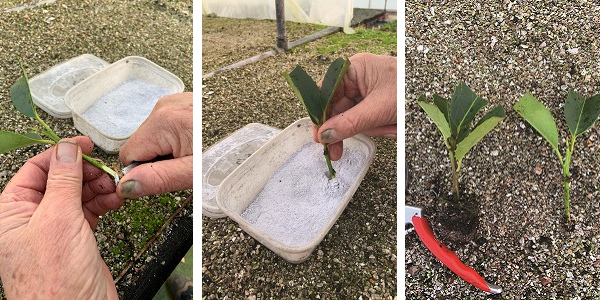 From left to right: 1. Making a wound in an ilex cutting before dipping in hormone rooting powder / 2. Dipping the cutting in hormone rooting powder / 3. A rooted (left) and unrooted (right) ilex cutting
From left to right: 1. Making a wound in an ilex cutting before dipping in hormone rooting powder / 2. Dipping the cutting in hormone rooting powder / 3. A rooted (left) and unrooted (right) ilex cutting
Propagation Glossary
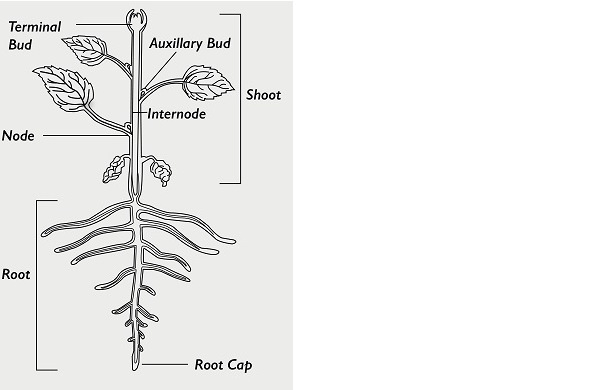
Internode: the region between two nodes.
Node: A point of connection. A node is the part of the stem where the leaves and lateral buds are attached. They look like raised portions of the stem, which can make them harder to spot than, say, buds.
Propagation: Breeding specimens of plants by natural processes from parent stock.
Alan Postill Biography
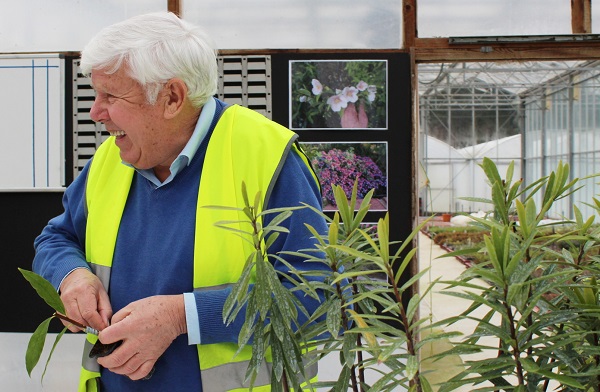
Career Highlights
Having joined Hillier at the tender age of 15, Alan has worked with a long list of notable propagators and plantsmen and, after 60 years, is recognised as one of the world’s top experts in his field.
Position at Hillier
Propagator and Plant Hunter at Hillier Nurseries in Hampshire.
Key Areas of Specialism
All forms of propagation – grafting, root cuttings, growing from seed.
Plants Raised by Alan
Daphne bholua ‘Jacqueline Postill’ (named after his wife, Jacqui)
Choisya x dewittiana ‘Aztec Gold’
Cotinus ‘Candy Floss’
Cotinus ‘Rose Glow’
Digitalis purpurea ‘Serendipity’


